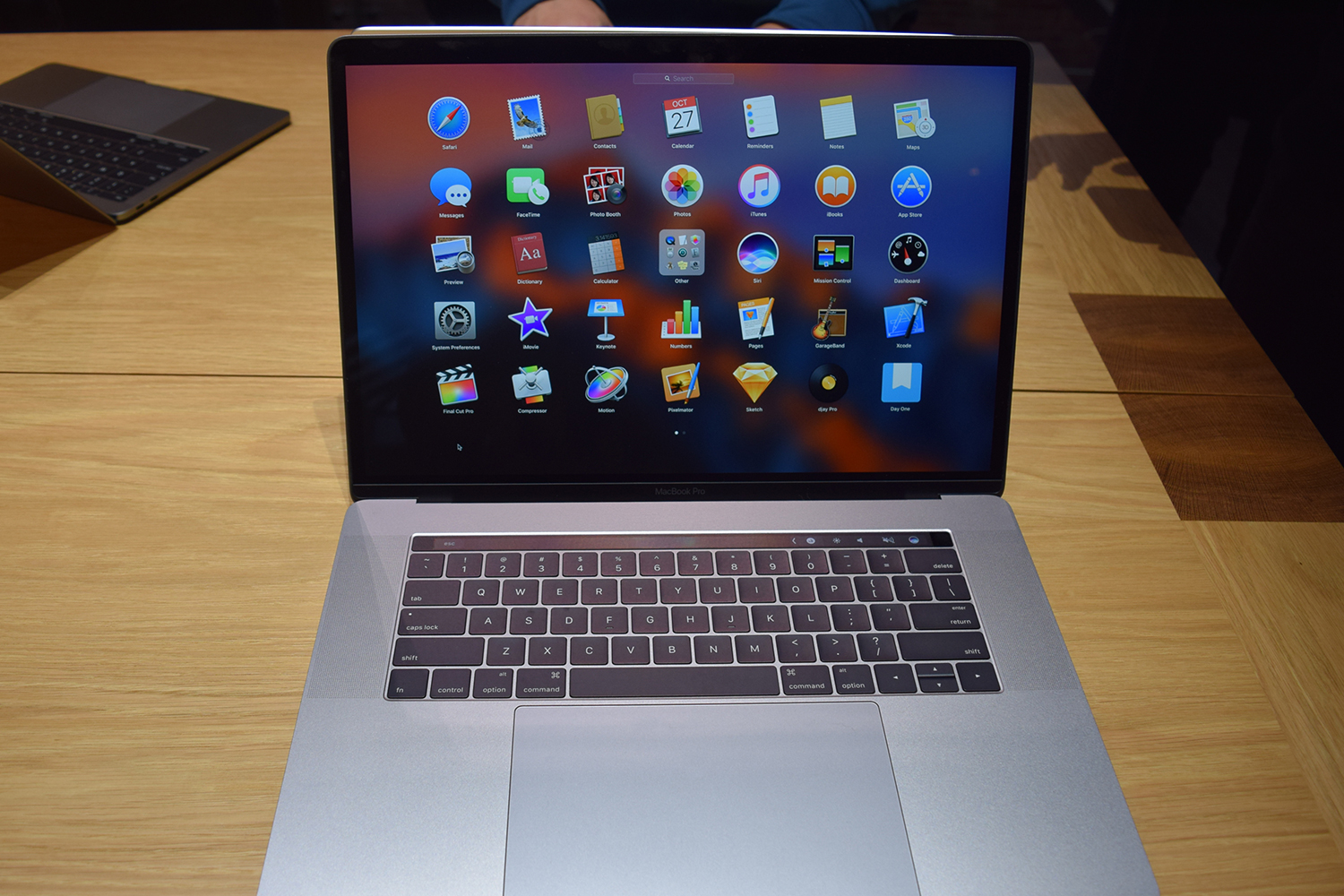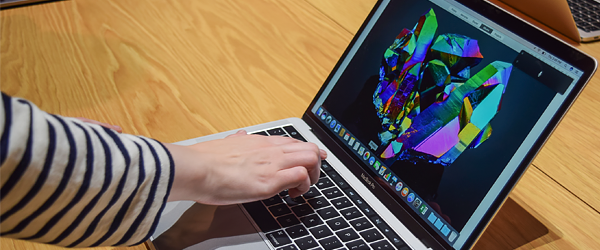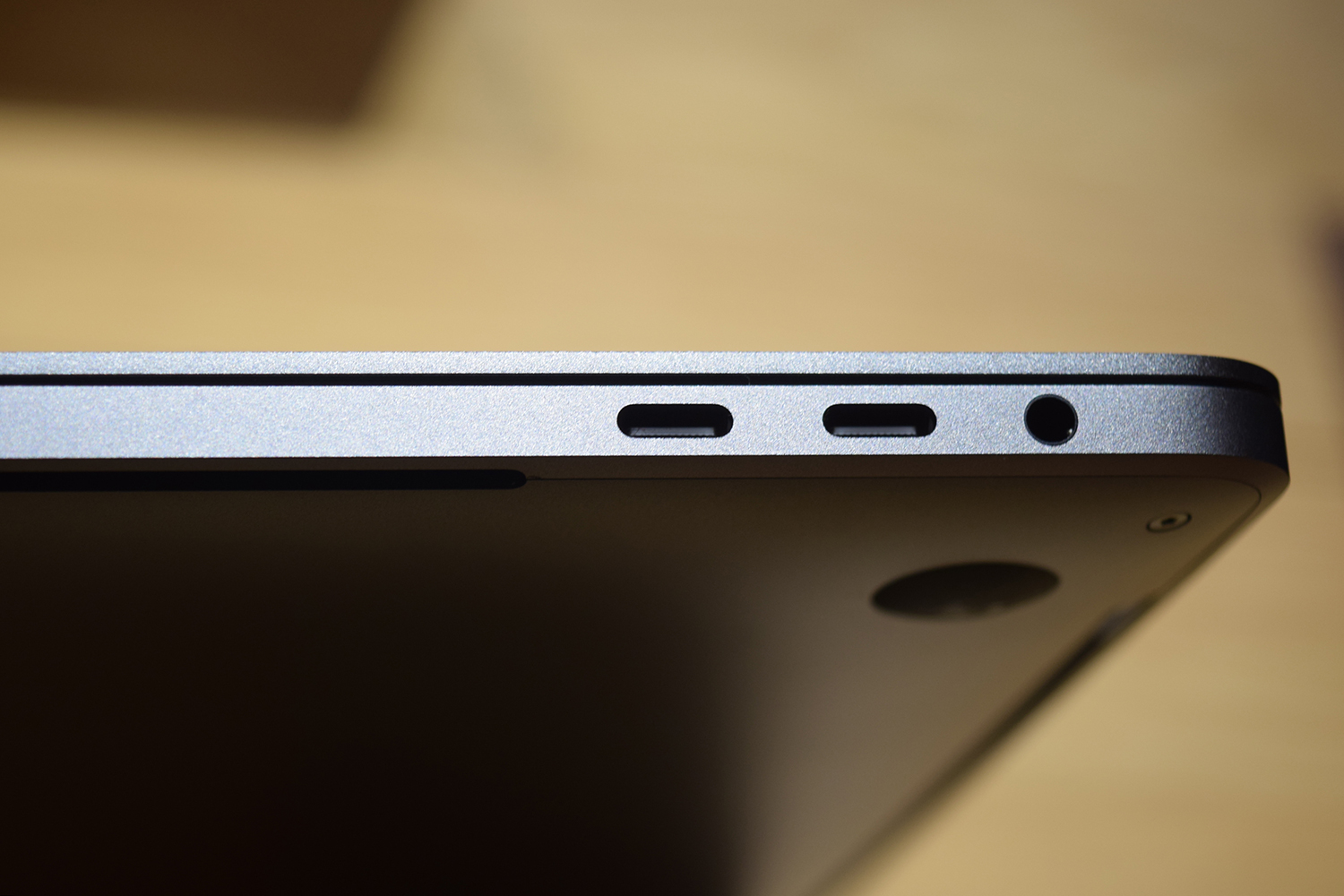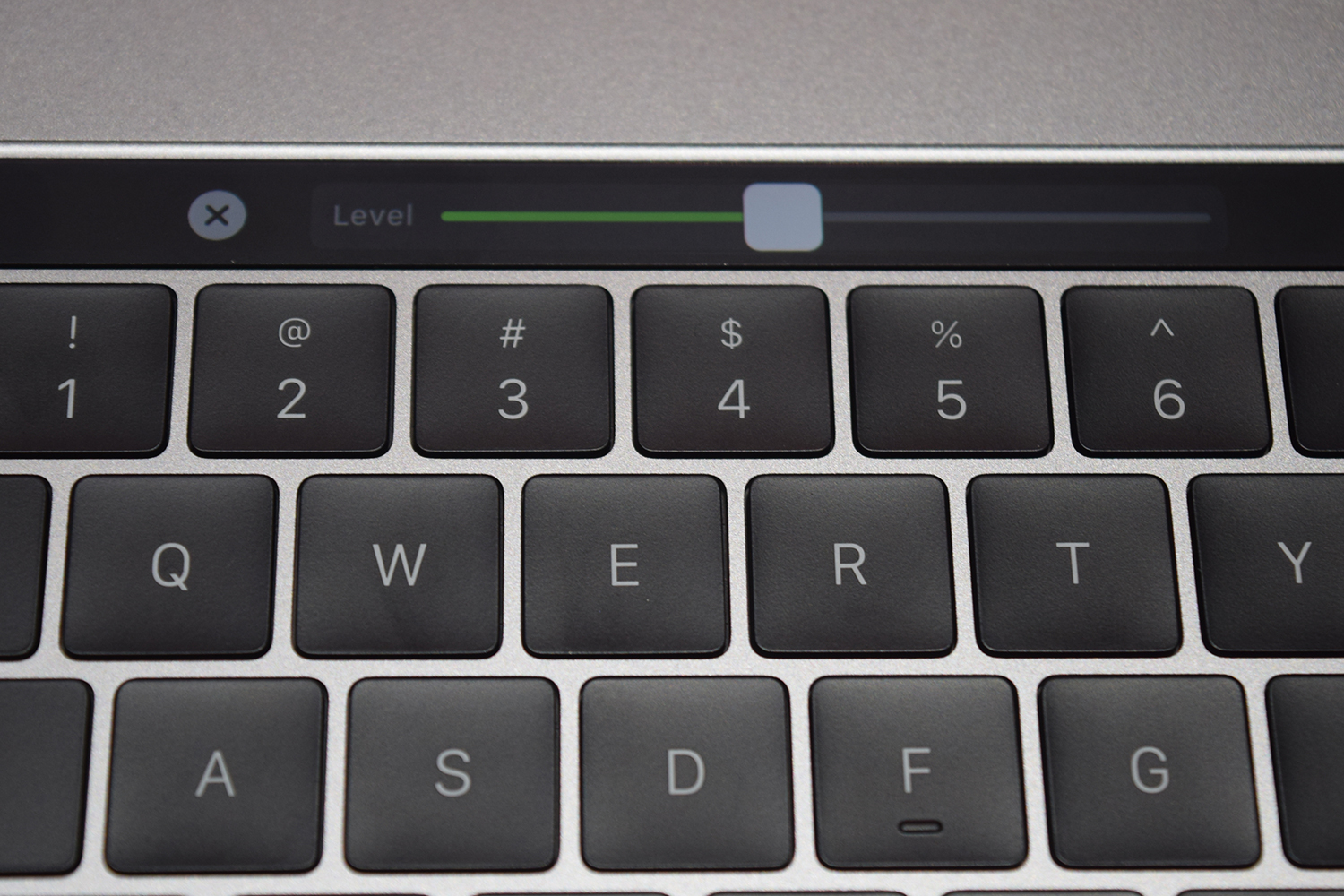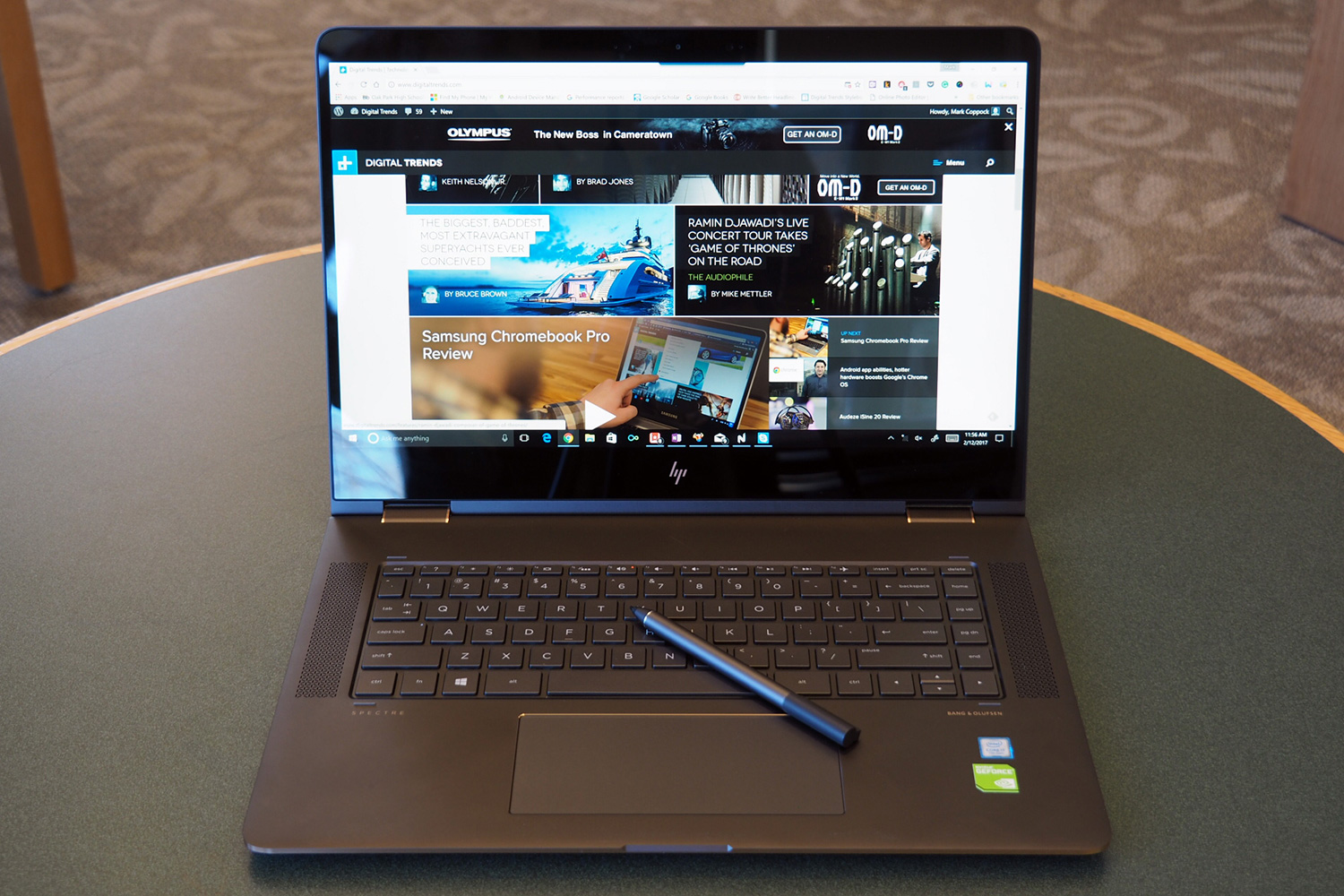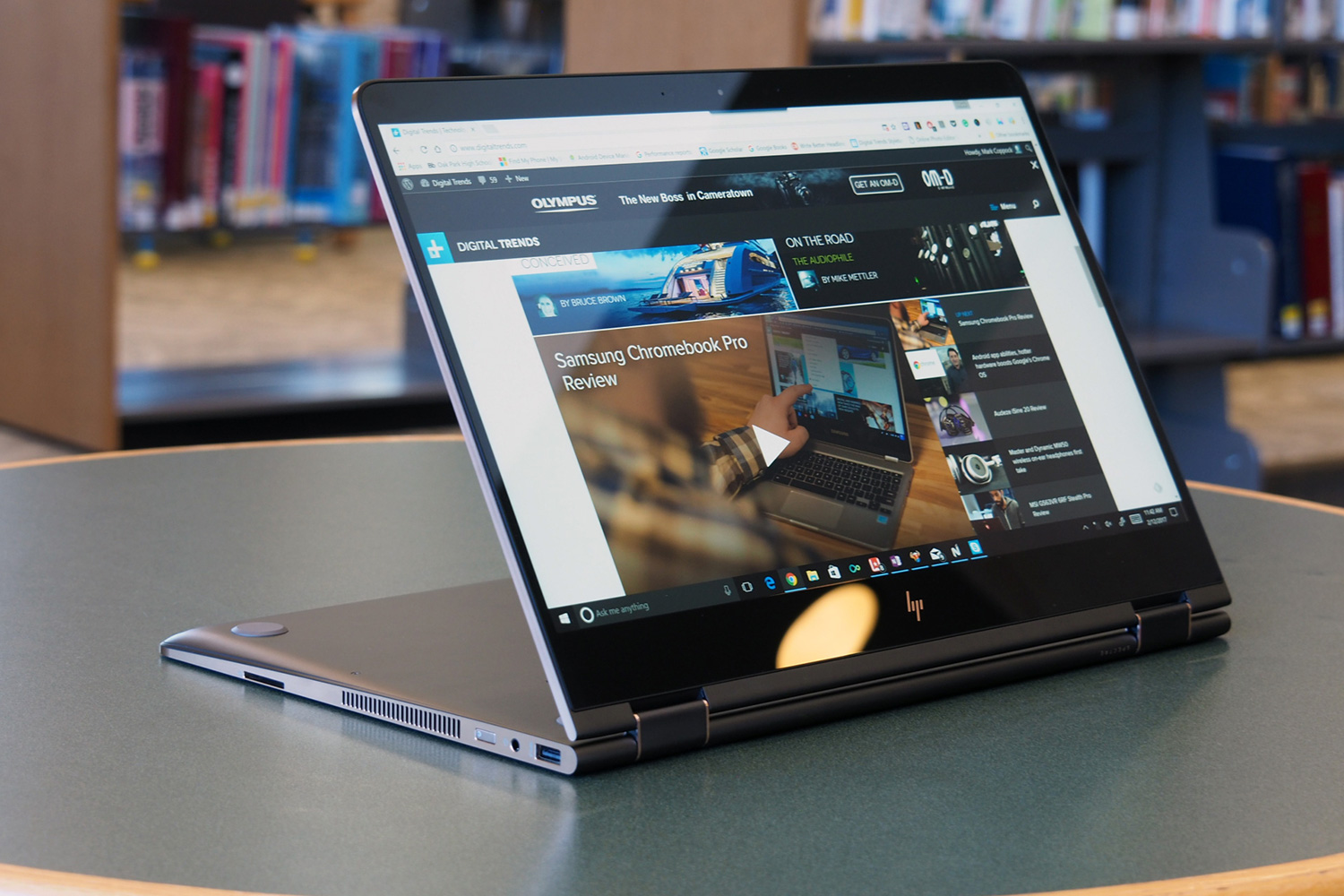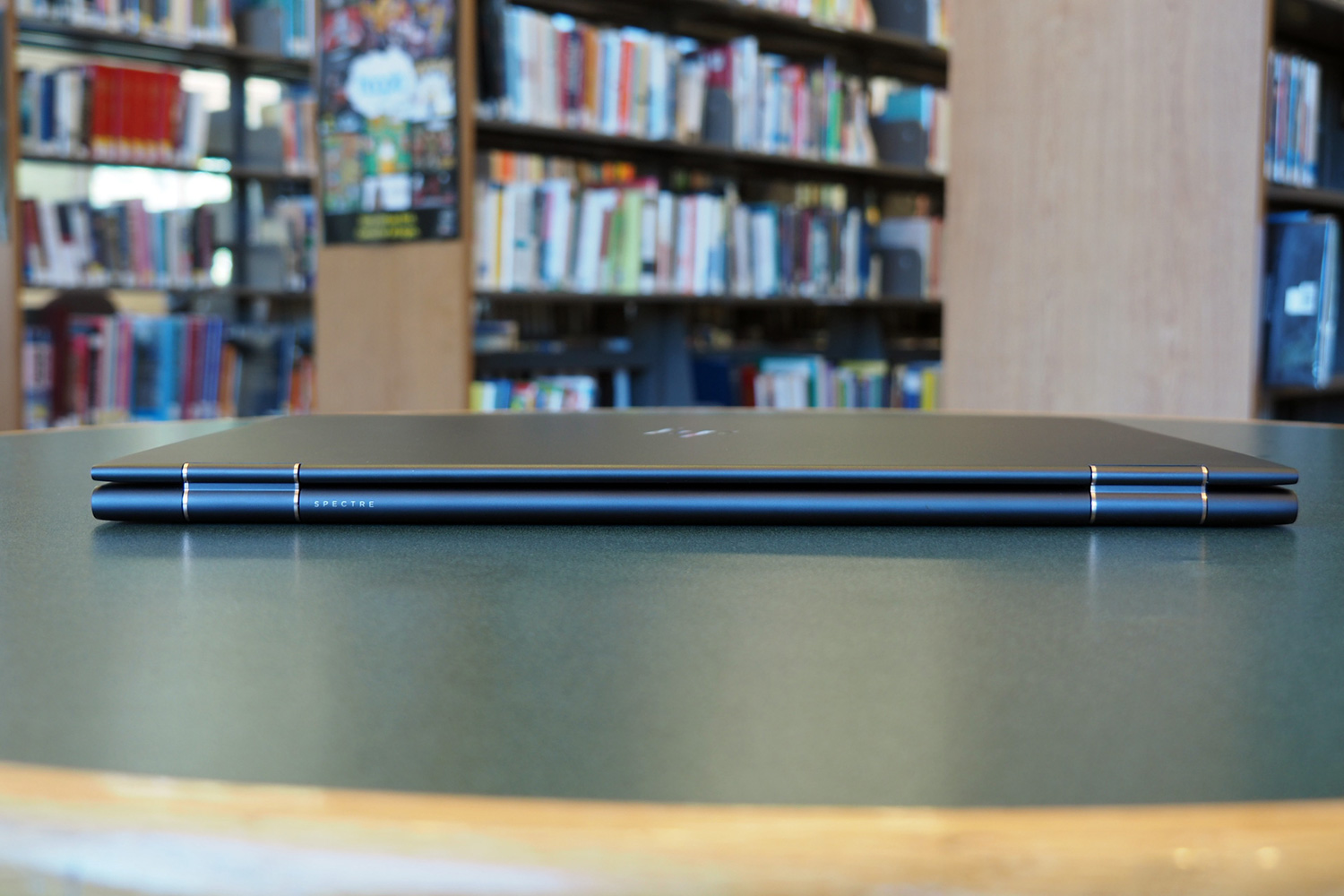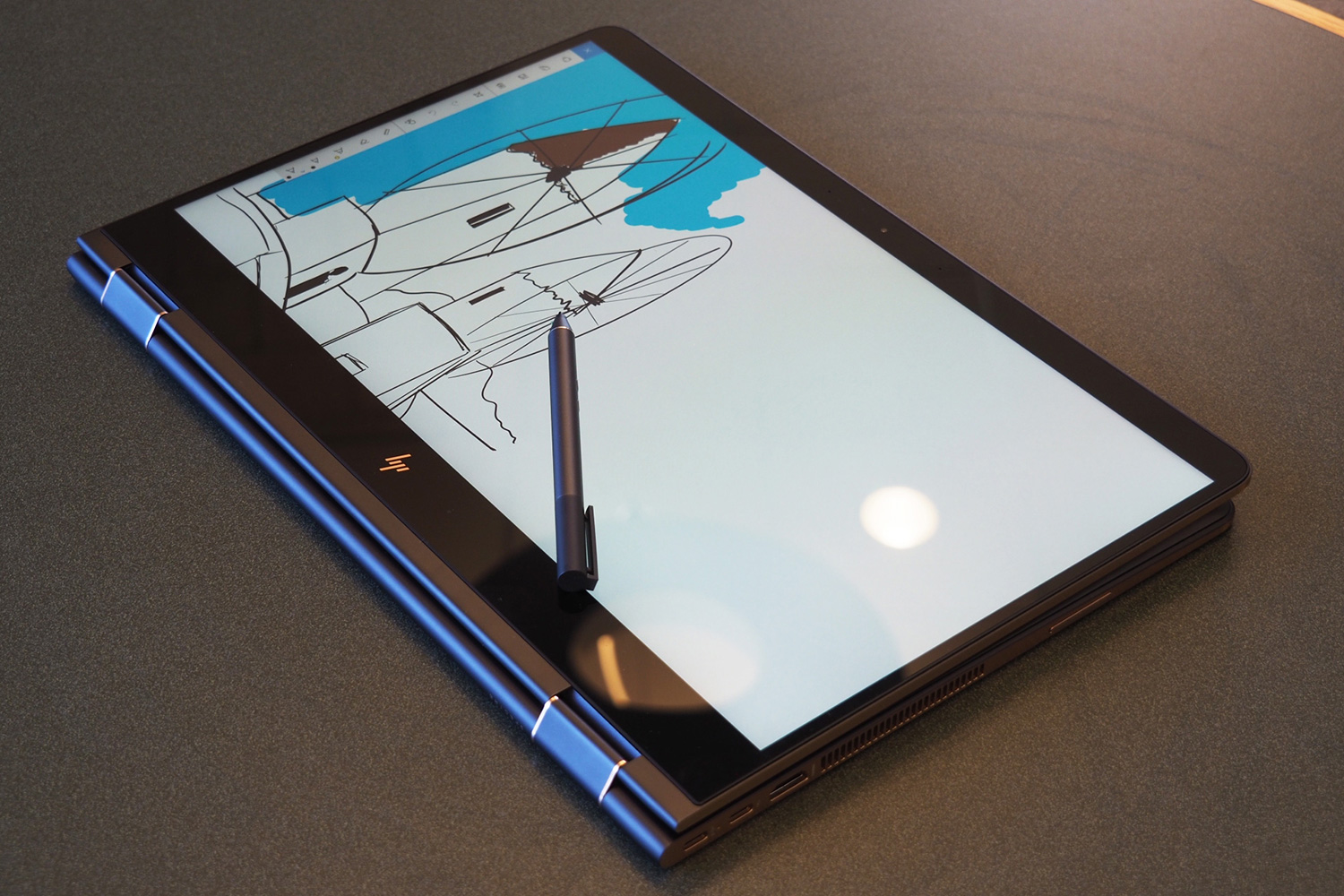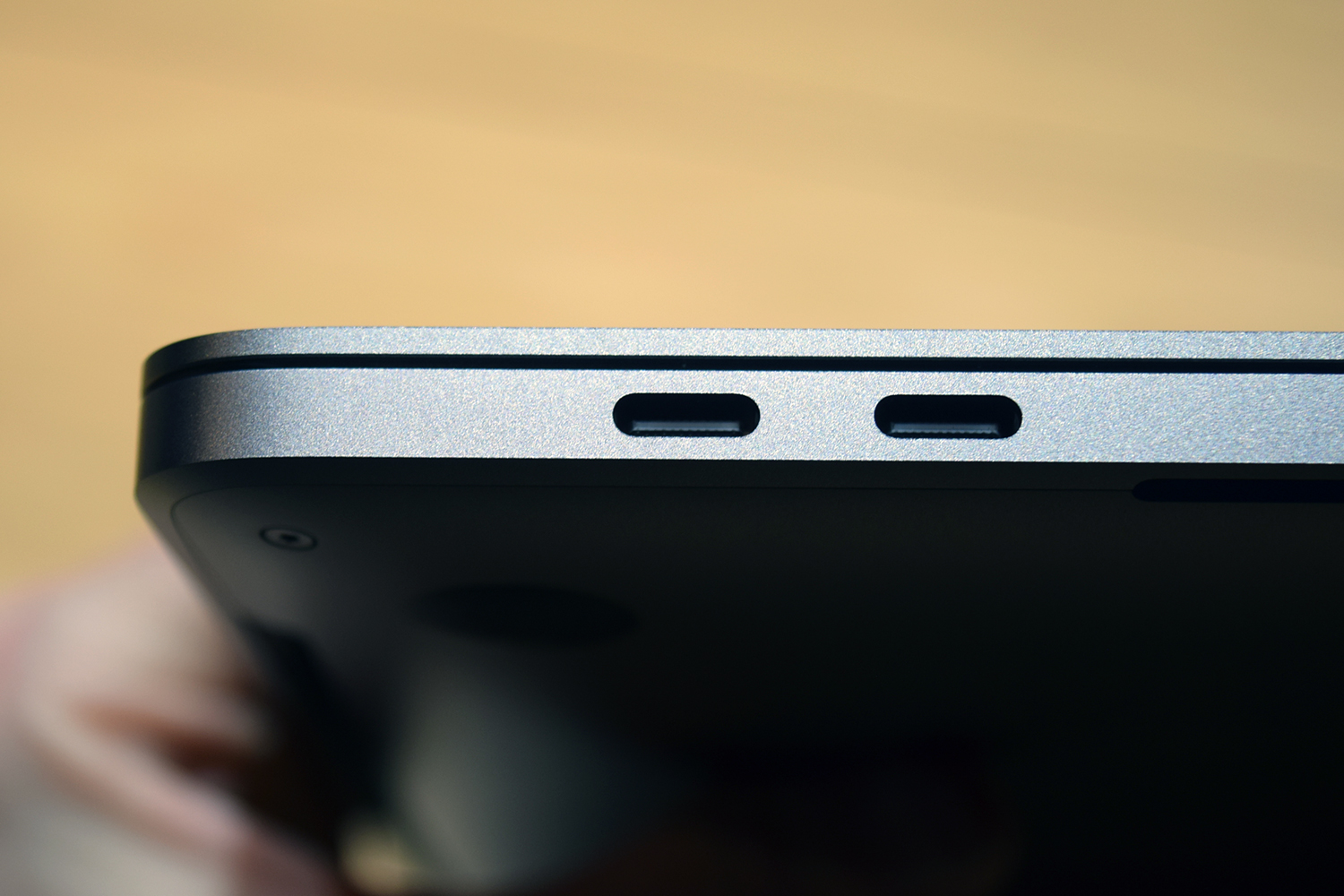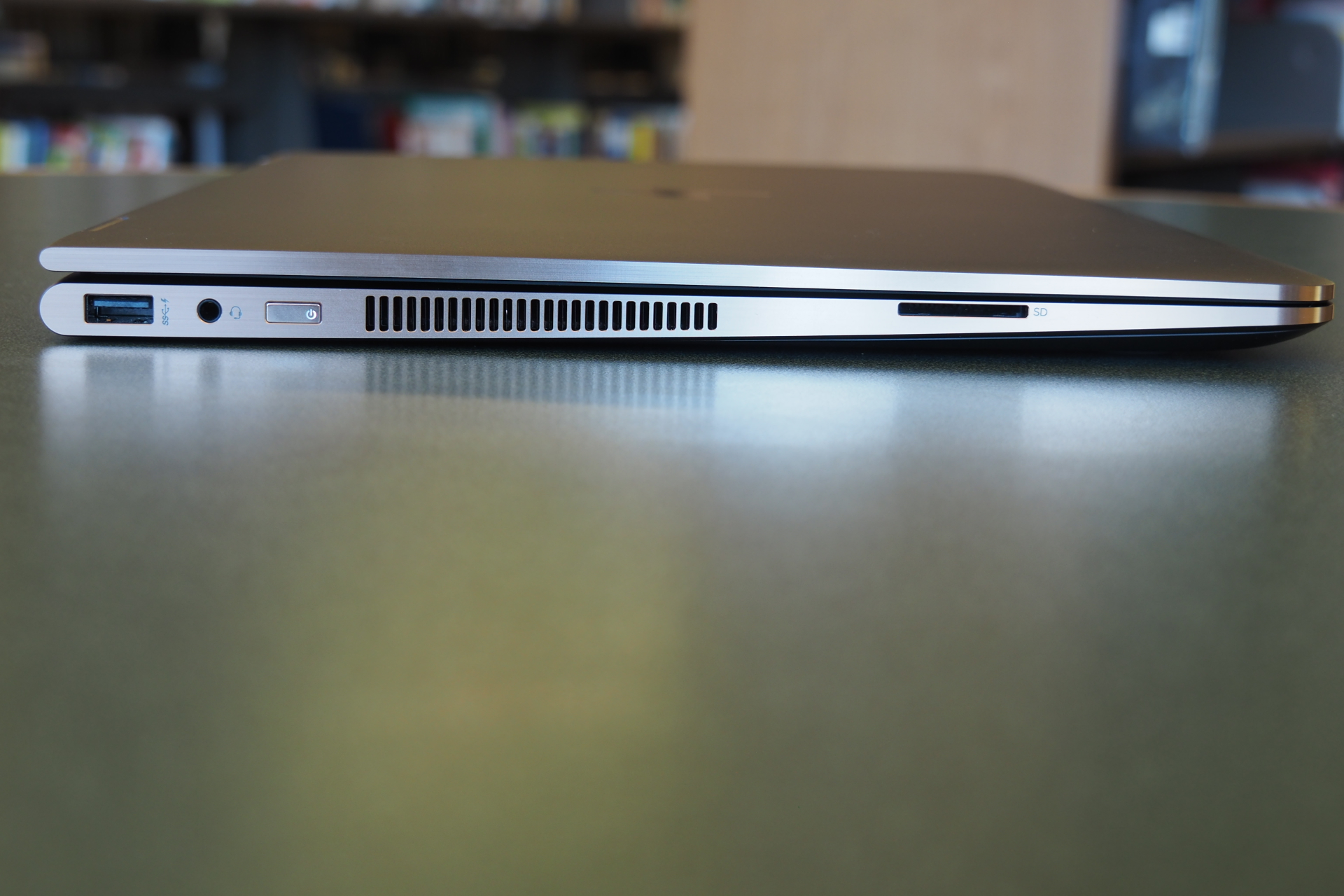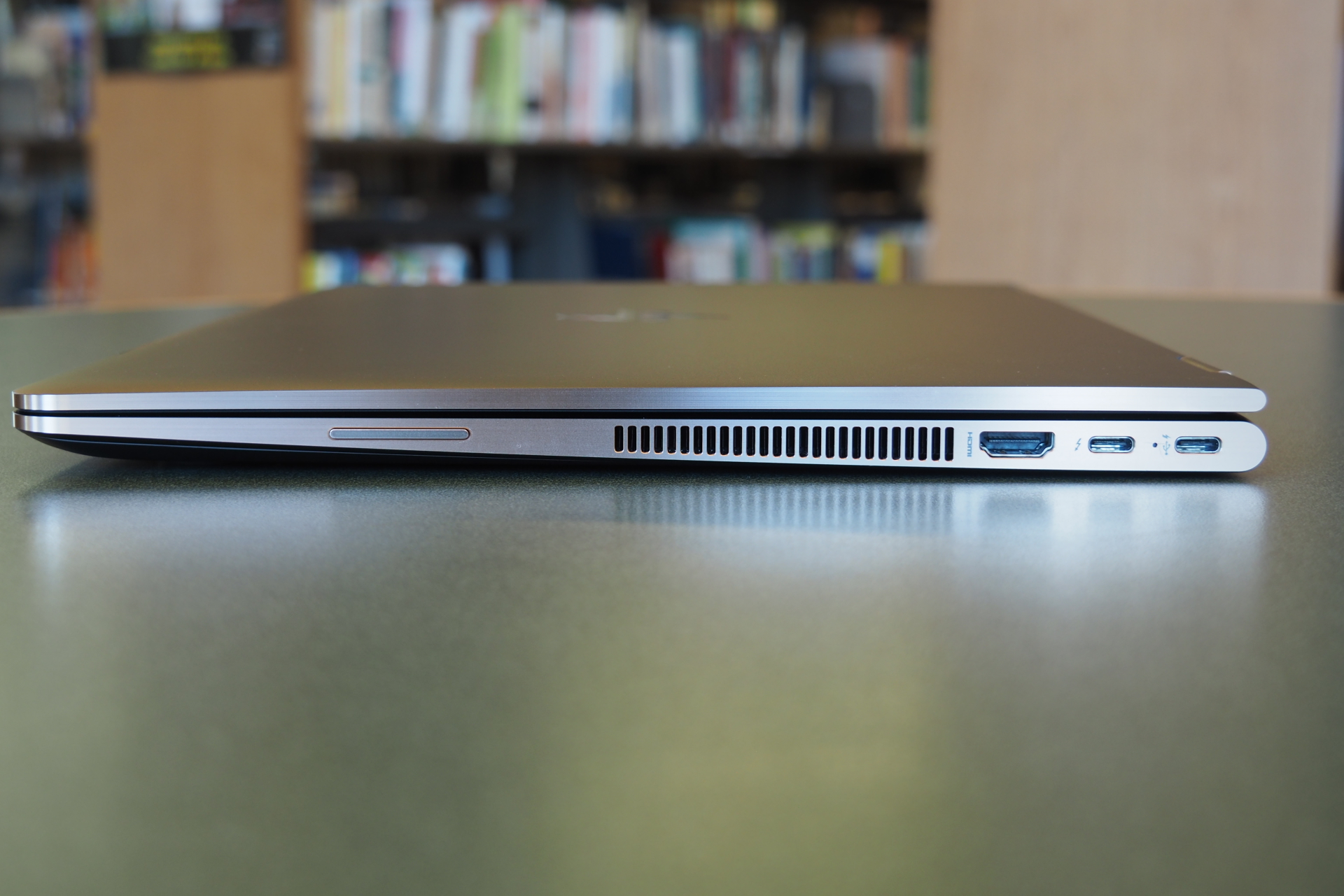
HP went in the opposite direction with its refresh of the Spectre x360 15, however, outfitting the Windows 2-in-1 with a thicker chassis designed to accommodate a larger battery, thus allowing it to power the machine’s 4K UHD display. Adding thickness also lets HP outfit the machine with an excellent full-travel keyboard and a few legacy ports to go along with the device’s USB Type-C connections.
Which approach — thicker or thinner — results in the best machine, though? Read on to find out whether it’s the HP Spectre x360 15 or the 2016 15-inch MacBook Pro that benefits the most from the recent design changes.
Specifications Compared
|
MacBook Pro 15-inch  |
HP Spectre x360 15  |
|
| Dimensions | 13.75 x 9.48 x .61 (in) | 14.00 x 9.88 x .70 (in) |
| Weight | 4.02 pounds | 4.42 pounds |
| Processor | 6th Generation Intel Core i7 quad-core | 7th Generation Intel Core i7 dual-core |
| RAM | 16GB LPDDR3 | 8 or 16GB DDR4 |
| Display | 15.6-inch IPS display | 15.6-inch IPS touchscreen |
| Resolution | 2,880 x 1,800 | 3,840 x 2,160 |
| Storage | 256GB, 512GB, 1TB, 2TB PCIe SSD | 256GB, 512GB, 1TB PCIe SSD |
| Networking | 802.11ac, Bluetooth 4.2 | 802.11ac, Bluetooth 4.2 |
| Ports | 4 x Thunderbolt 3, 3.5mm | 1 x USB 3.0, 1 x USB Type-C, 1 x USB Type-c with Thunderbolt 3, 1 x HDMI, Headset, SD Card reader |
| Webcam | 720p FaceTime HD | 1080p webcam with IR camera and Windows Hello support |
| Operating System | MacOS Sierra | Windows 10 |
| Battery | 76 watt-hours | 79.2 watt-hours |
| Price | $2,399+ | $1,280+ |
| Availability | Available now | Available late-February |
| Review | Hands-on | 4 out of 5 stars |
One battery got smaller, the other got bigger
The new 15-inch MacBook Pro is significantly thinner than its predecessor, coming in at 0.61 inches compared to 0.71 inches — a 14 percent reduction. The display bezels are also thinner, meaning all dimensions are smaller. It weighs 4.09 pounds, too, which makes it almost a half a pound lighter than the previous model.
The Spectre x360, on the other hand, got a little thicker, but also lost some width thanks to thinner bezels. The thicker chassis results in increased weight, though, bringing the laptop to 4.42 pounds.

Apple’s thinner design resulted in a 24-percent reduction in battery capacity, taking it from 97 watt-hours to 76 watt-hours. While we haven’t tested battery life on the 15-inch model, the 13-inch MacBook Pro with Touch Bar — which touts similar battery life — provided only average longevity compared with similar Windows 10 machines.
The HP Spectre x360 15, on the other hand, added a little thickness and increased battery capacity by 23 percent, from 64.5 watt-hours to 79.2 watt-hours. The new machine also utilizes Intel’s seventh-generation CPUs. Both improvements help HP meet its goal of ensuring the new model and its 4K UHD display will last as long as last year’s Full HD version. HP promises up to 12 hours and 45 minutes of battery life, though, our own test results show a little over 10 hours.
That doesn’t mean that the Spectre x360 beats out the MacBook Pro in terms of battery life. Apple’s efficiency and the display’s lower resolution means that the Spectre x360 15 likely loses this round, although not by much. Both offer enough battery life to last a typical work day — depending on the workload — but we can only imagine how much longer the MacBook Pro would last if Apple had kept battery capacity the same.
Winner: 15-inch MacBook Pro
Old design vs. new design
Apple maintained the classic MacBook Pro appearance with its newest iteration, opting for the same aluminum chassis and elegant, understated design that adorned its predecessor. The new MacBook Pro looks a lot like the old MacBook Pro, only it’s thinner and comes with smaller bezels. It’s a good look that fits well in any professional environment, but at this point, it’s getting a little stale.
Apple supersized the touchpad, however, making 50-percent larger and outfitting it with the company’s Force Touch technology. But, the company squished the keyboard, leaving users either loving the second-gen keyboard or lamenting the loss of the old-school MacBook Pro keyboard. Nonetheless, the most significant addition is the Touch Bar, which functions as an OLED touchscreen display. The component resides above the keyboard — displacing the physical function keys — and responds to the application at hand with task-specific buttons.
HP, on the other hand, took the silver chassis on last year’s Spectre x360 15 and gave it a paint job. This year’s model touts a darker exterior with copper accents. As with all such aesthetic decisions, some might love it and some might hate it, but we think it’s an equally elegant look that’s classy without blending into the sea of Windows 10 machines.
HP’s decision to increase thickness a bit means the Spectre x360 15 has a full-travel keyboard that makes for an extremely comfortable typing experience. The touchpad is also fairly large, with the same widescreen aspect ratio as the display. Most important, though, is that the Spectre x360 15 is also a 2-in-1 with a touchscreen and an active pen. It offers the always-convenient presentation and tent modes, along with occasional tablet use that leverages the excellent pen with Windows 10 Ink support. And a 10-point multitouch display beats out a narrow OLED strip any day.
Both machines are well-built and exude quality. We think the HP’s design is fresher and more striking, though, and its 2-in-1 design and excellent keyboard give it the nod over Apple’s somewhat outdated MacBook Pro and its too-shallow keyboard. The MacBook Pro is a bit smaller and lighter, but that’s not enough to make up for what it compromises in the name of being so thin.
Winner: HP Spectre x360 15
May the quickest laptop win
The quad-core version of Intel’s seventh-generation Core i7 processors wasn’t available in time for the release of the 2016 MacBook Pro. Instead, the machine utilizes the sixth-generation Core i7-6920HQ. A standard 16GB of LPDDR3-2133 RAM is the only option, though the machine can be configured with a 2TB SSD. You can also outfit it with a AMD Radeon Pro 460 and 4GB of GDDR5 memory, switchable with the Intel HD Graphics 530.
The HP Spectre x360 15 is a decidedly mid-range system, with a seventh-generation Intel Core i7-7500U dual-core processor. You can configure it with up to 16GB of DDR4-2133 RAM and 1TB SSD, though the only graphics option is an Nvidia GeForce GTX 940MX, which goes along with the Intel HD Graphics 620.
In short, the MacBook Pro is a more powerful machine with higher-end CPU and GPU options — and this is in spite of its last-gen processor. The Spectre x360 15 is no slouch, however, and performs well for its class while offering the same amount of RAM as Apple’s machine and a large SSD. It’s not as large as the highest-end MacBook Pro configuration, but it’s certainly not terrible.
The MacBook Pro is definitely the faster performer and will crunch through massive images and videos significantly more quickly than the Spectre x360 15. If you’re looking for professional power, then Apple’s machine is the better option.
Winner: 15-inch Macbook Pro
Connectivity conundrums
Another casualty of Apple’s pursuit of thinness is connectivity, or maybe it’s Apple’s usual desire to push the envelope and adopt the latest technology as a means of killing off legacy devices. Regardless, the MacBook Pro completely eschews legacy connections and includes four USB Type-C ports. All of the ports support Thunderbolt 3, too, rendering them the highest-performing and most versatile ports around. That also means that you’ll need dongles — and lots of them — to support literally all of your legacy USB, HDMI, or DisplayPort peripherals.
HP, on the other hand, took a step into the future while keeping a foot in the past. The Spectre x360 15 has two USB Type-C ports, one of which supports Thunderbolt 3, along with a USB 3.0 port and a full-size HDMI connection. HP also retained the SD card reader, something else that Apple dropped from the MacBook Pro, much to the consternation of some Mac users.
If you only plan on plugging in USB Type-C devices, or are perfectly fine with purchasing and carrying around a number of dongles, then you’ll appreciate Apple’s decision to stuff four Thunderbolt 3 ports into the MacBook Pro. If you still have legacy devices you need to plug in, or don’t want to be stuck without a dongle while you’re on the road, then the Spectre x360 15 is the better choice. Personally, we think keeping in touch with the past is a good idea, and it’ll be a few years before legacy devices disappear altogether.
Winner: Spectre x360 15
Apple’s display is still hard to beat
The MacBook Pro has an excellent, 15.6-inch IPS display that boasts 500 nits of brightness and an extremely wide color gamut that meets the P3 specification. That means it’s a gorgeous display that’s capable of meeting the needs of most creative professionals. It also meets Apple’s Retina designation at a resolution of 2,880 x 1,800, or 220 pixels per inch. Simply put, it’s a lovely display.
HP put a good, but not great, 15.6-inch IPS display in the Spectre x360 15. It’s not nearly as bright, with HP claiming 340 nits of brightness, and our tests concluded that it offers 74-percent AdobeRGB and 95-percent sRGB color gamut support. It’s a 4K UHD display with 3,840 x 2,160-pixel resolution, however, with 282 pixels per inch. Its perfect gamma of 2.2 — according to our tests — means that images and video are neither too bright or too dark. Watching movies at
If you need a high-quality display with good resolution and professional color support, then the MacBook Pro beats out the Spectre x360 15’s higher-resolution, 4K panel. If your needs skew to watching movies and general productivity, then the Spectre x360 15 is a good choice. We’ll give the nod to the Apple here, but the HP has nothing to be ashamed of.
Winner: 15-inch MacBook Pro
Availability and price
Apple’s “pro” moniker is no joke, with the MacBook Pro taking its place among the most expensive notebooks outside of insanely configured gaming systems. The entry-level model with the Core i7-6700HQ, 16GB RAM, 256GB SSD, and AMD Radeon Pro 450 is priced at $2,399. With a 512GB SSD to match the HP’s configuration, the price is $2,599. The most expensive MacBook Pro is firmly in the stratosphere, given it costs $4,299 for a Core i7-6920HQ, 16GB
HP’s Spectre x360 15 is a more affordable system. The low-end machine with the Core i7-7500U, 8GB RAM, and 256GB SSD runs $1,280. The machine with 16GB
Again, if you need the quad-core processor, higher-spec’d GPU, and professional color afforded by the MacBook Pro, then you’re likely willing to spend the money. Like many other MacBook Pro users, however, you might be disappointed by some of Apple’s design decisions and the lack of a 32GB RAM configuration. The HP Spectre x360 15 offers a great deal for the money, making it a tremendous value.
In the end, we have to give the nod to the HP for the vast majority of people. At a significantly lower price point, the Spectre x360 15 represents a great system for a lot less money, and better meets the needs of its target market. Apple will likely have to take more aggressive steps to make a MacBook Pro that’s more suitable for the professional users the company seems to be targeting.
Winner: Spectre x360 15
Conclusion
We’re comparing two machines that are each the latest revisions of existing lines. In some ways, they’re significant revisions, with both companies changing the form factors in terms of size and weight and impacting each machine’s functionality.
Apple went thinner and lighter, and in turn reduced the functionality of a professional machine. Battery life was compromised, the luscious full-travel keyboard was swapped out for something far less comfortable, and while it’s a future-looking machine in terms of connectivity, it completely left the past behind. Apple also failed to move the machine forward for its highest-end, dare we say most professional users, by sticking with last-gen CPUs, failing to up the GPU specifications, and leaving out a 32GB RAM configuration. The Touch Bar is a nice touch, but there’s not much that’s both new and a significant step forward.
HP, on the other hand, added a little thickness and weight but provided a ton of value and a machine that’s well-suited for the vast majority of users. It won’t meet the needs of the same power users who are unhappy with the new MacBook Pro, but then again, it’s not playing to that market. Instead, it’s aimed at creative professionals and mainstream users who want a lovely 4K display, very good performance, usable battery life, and who don’t want to spend an arm and a leg for any of it.
We tend to think HP took the right path with the Spectre x360 15, better meeting the needs of its target market and as HP itself would say, providing a more optimized, rather than compromised, solution. Apple, on the other hand, went somewhere else with the latest MacBook Pro, ultimately failing to meet the needs of the customers who most desire the machine while pricing out many users who might appreciate its svelte frame and functional compromises.

